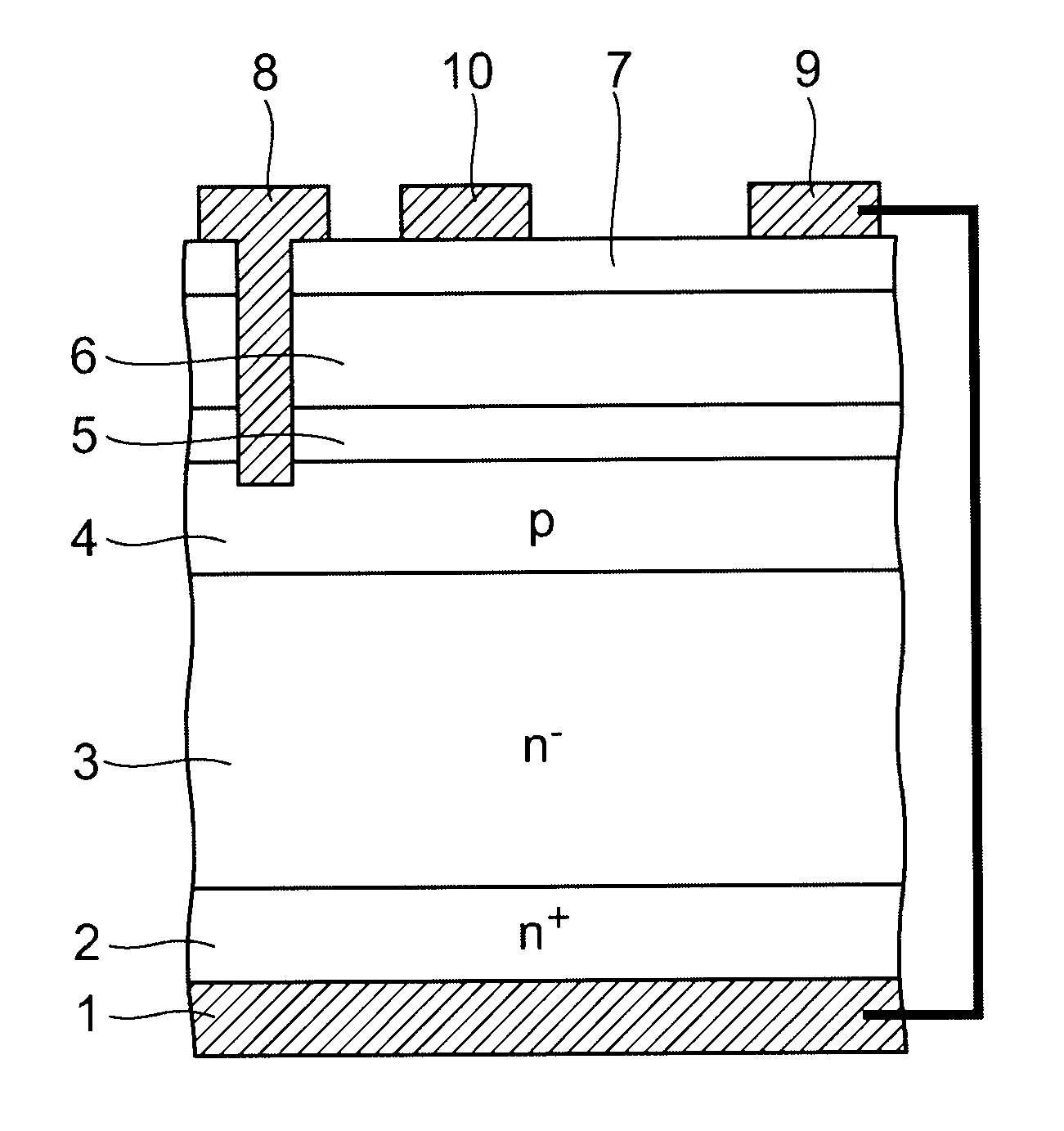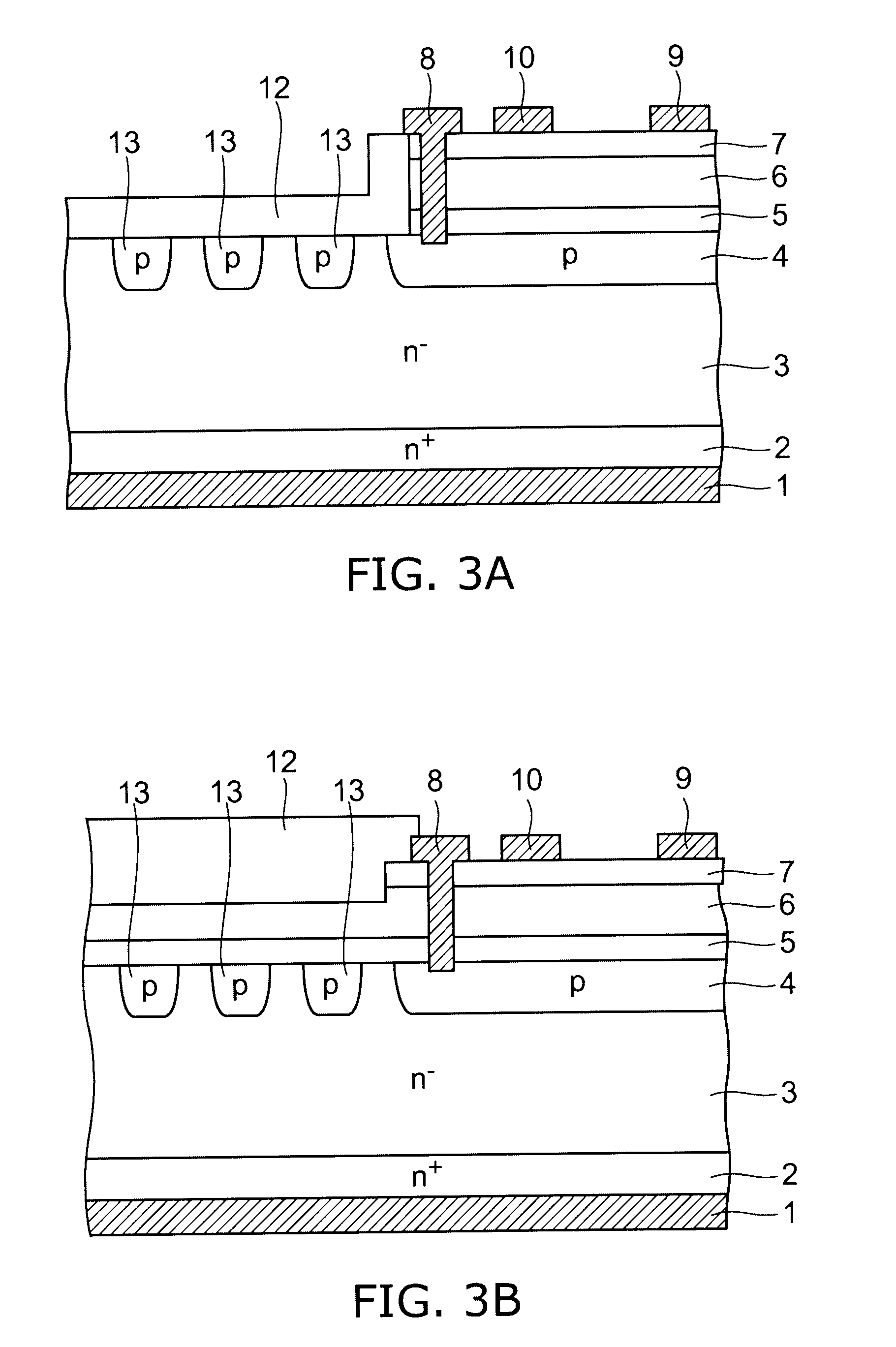Semiconductor apparatus
a technology of nitride semiconductor and semiconductor, applied in the direction of electrical devices, semiconductor devices, diodes, etc., can solve the problems of low resistance and power devices such as avalanche capability not being taken into account, and achieve the effect of higher resistan
- Summary
- Abstract
- Description
- Claims
- Application Information
AI Technical Summary
Benefits of technology
Problems solved by technology
Method used
Image
Examples
first embodiment
[0020]FIG. 1 is a schematic view showing the principal cross-sectional structure of a semiconductor apparatus according to a first embodiment of the invention.
[0021]On the major surface of a highly doped n+-type silicon layer (or silicon substrate) 2 serving as a first silicon layer, an n−-type silicon layer 3 is provided as a second silicon layer. A p-type silicon layer 4 is provided as a third silicon layer on the major surface of the n−-type silicon layer 3. The n−-type silicon layer 3 has a lower impurity concentration and a higher resistance than the n+-type silicon layer 2 and the p-type silicon layer 4.
[0022]A heterojunction structure of a channel layer 6 serving as a first nitride semiconductor layer and a barrier layer 7 serving as a second nitride semiconductor layer, which has a larger bandgap than the channel layer 6, is provided via a buffer layer 5 on the major surface of the p-type silicon layer 4.
[0023]For example, the channel layer 6 is made of undoped GaN, and the ...
second embodiment
[0035]FIG. 3A is a schematic view showing the principal cross-sectional structure of a semiconductor apparatus according to a second embodiment of the invention.
[0036]In this embodiment, one or more (in the example shown, three) p-type guard ring layers 13 are selectively provided as fourth silicon layers in the surface of the n−-type silicon layer 3 in the termination section, which is located on the outer periphery side of the device section including the pin diode and the overlying HFET. The surface of the termination section including the guard ring layers 13 is covered with a field insulating film 12.
[0037]Thus, even if a depletion layer extends from the p-type silicon layer 4 of the device section toward the termination section, the guard ring layer 13 prevents electric field concentration at the end of the p-type silicon layer 4, achieving stable breakdown voltage. Furthermore, prevention of electric field concentration at the end of the p-type silicon layer 4 allows an avala...
third embodiment
[0042]FIG. 4 is a schematic view showing the principal cross-sectional structure of a semiconductor apparatus according to a third embodiment of the invention.
[0043]In this embodiment, an insulator 14 such as silicon oxide and silicon nitride is provided between the channel layer 6 and the n−-type silicon layer 3 below the drain electrode 9. In this structure, when a high voltage is applied to the drain electrode 9, the voltage is also applied to the insulator 14. Thus, the voltage is held by both the channel layer 6 and the insulator 14. Hence, the channel layer 6 does not need to be so thickened for the purpose of ensuring adequate breakdown voltage. Because the channel layer 6 can be thinned, a crack-free AlGaN / GaN heterojunction structure of the barrier layer 7 and the channel layer 6 can be easily formed, and the substrate warpage can be also reduced.
[0044]The structure shown in FIG. 4 can be realized by forming a groove extending from the surface of the p-type silicon layer 4 ...
PUM
 Login to View More
Login to View More Abstract
Description
Claims
Application Information
 Login to View More
Login to View More - Generate Ideas
- Intellectual Property
- Life Sciences
- Materials
- Tech Scout
- Unparalleled Data Quality
- Higher Quality Content
- 60% Fewer Hallucinations
Browse by: Latest US Patents, China's latest patents, Technical Efficacy Thesaurus, Application Domain, Technology Topic, Popular Technical Reports.
© 2025 PatSnap. All rights reserved.Legal|Privacy policy|Modern Slavery Act Transparency Statement|Sitemap|About US| Contact US: help@patsnap.com



